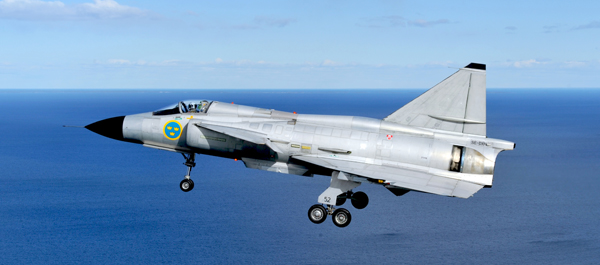
The Swedish Air Force Historic Flight has certified a Viggen, which is now part of its team of airworthy former SAF jet fighters.
One of the rarest and most unusual Cold War fighters is flying again. The Swedish Air Force Historic Flight has certified (on the civilian registry) a Viggen, which is now part of its team of airworthy former SAF jet fighters: a Saab Tunnan, Lansen, Draken and now the Viggen, plus a de Havilland Vampire and Hawker Hunter. The SAFHF regularly flies its stars at airshows throughout Europe, where the Viggen will doubtless perform its favorite trick: a full-reverse-thrust, hard-braking short landing, then a reverser-powered backward U-turn on the runway, followed by a full-burner takeoff within the same space used for the landing.
Only 329 Viggens were built, and the last one flew in 2007. Saab was never able to sell Viggens to a single foreign air force despite pitching it at all the big military airshows in the 1970s and early ’80s. Part of the reason probably was that it was designed to defend a comparatively small country with limited overwater needs. It was supersonic at low altitudes and Mach 2.1-capable at altitude, but full afterburner would suck up its entire internal fuel load in just seven minutes. The Viggen carried missiles plus one of the largest cannons ever fitted to a fighter—a 30mm Oerlikon—and had a very sophisticated radar/autopilot-link automatic fire-control system.
The Viggen danced to a different drummer when Saab designed it as the first tailless delta-winged fighter with a canard. Its canard is fixed, not a control surface, and adds little lift in cruise, but serves as a big vortex generator for the flapless main wing at STOL speeds. It has its own flaps to raise the nose and add drag on approach. (Those flaps come down automatically with gear extension and are not controllable by the pilot.)
The Viggen also made no-flare landings with a 15-foot-per-second sink rate, and its head-up display was designed to work as a landing aid, allowing the pilot to hit a touchdown spot just 100 feet from a runway threshold. The pilot could also select extremely effective reverse thrust during the approach—the Viggen was the first airplane to have both an afterburner and reverser—and reverse would automatically activate when the nosewheel strut compressed. Such features allowed the Viggen to use short stretches of Swedish superhighways as runways.




